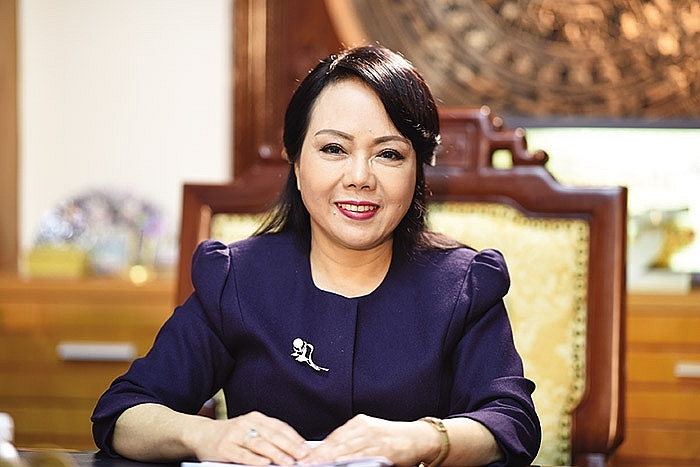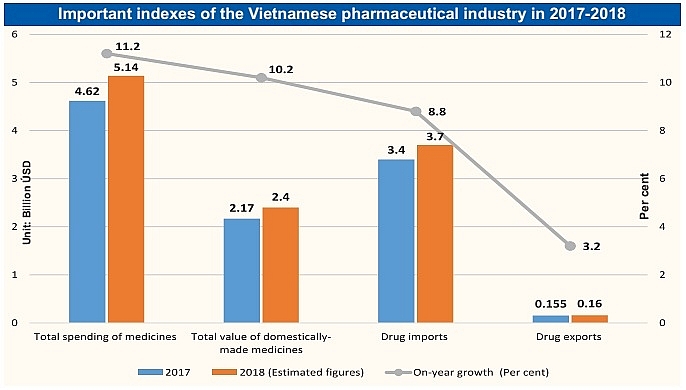The clear path to a healthier Vietnam
 |
| Nguyen Thi Kim Tien, Minister of Health |
 |
What are the highlights of the Ministry of Health’s (MoH) activities in 2018?
The year was a very special one for the healthcare sector, with many breakthrough achievements made, thus contributing to increasing access to healthcare for rural people, increasing the quality of examinations and treatment, developing the public-private partnership (PPP) model, and further facilitating business activities.
It was the first year that the MoH implemented Resolution No.20/NQ-TW on strengthening grassroots and primary healthcare towards universal health coverage, and Resolution No.21/NQ-TW on population work in the new period. Universal health coverage reached the rate assigned by the National Assembly. During the year, the sector also began to strongly develop local clinics by creating family medical practices in 26 communes before expanding to all communes nationwide in line with the model being developed in other countries.
The sector achieved many scientific achievements. For example, we produced a WHO-standard flu vaccine and a measles-rubella vaccine applying Japanese technology.
In terms of examination and treatment, Vietnam made great achievements in laparoscopy surgery, and for the first time, Vietnamese people successfully carried out lung transplants.
The quality has also been much improved, with more hospitals winning high satisfaction ratings of over 90 per cent, including Can Tho General Hospital, Quang Ninh General Hospital, Bac Ninh General Hospital, and the National Geriatric Hospital, among others.
Remarkably the sector, for the first time, successfully completed a very hard task: connecting drugstores with authorised management agencies, thus enabling them to control their prices, expiry dates, as well as quality and origin of drugs.
Also for the first time, price negotiation of drugs at tenders was carried out, thus helping lower costs.
It was also the year that the MoH built and submitted a decree on self-control at health clinics.
In terms of administrative reforms, the MoH is one of the ministries that rank high, by cutting over 72 per cent of business conditions and 72 per cent of administrative procedures. Notably, many procedures for specialised checks at border gates for food products were removed, with 95 per cent of imported food packages exempted from specialised checks, thus saving over VND3 trillion ($130.43 million) a year for businesses.
Regarding the PPP model development, the MoH urged hospitals to enter partnerships with the private sector by forming joint ventures and other forms to be equipped with advanced technologies and new buildings.
What shortcomings need to be solved to improve the sector’s performance in the time to come?
Besides the achievements, there do remain shortcomings that we are trying to improve. The sector has yet to pay due attention to taking care of healthy people, and the programme to fight non-communicable diseases (NCDs) remains limited. At present, 70 per cent of deaths come from chronic NCDs such as heart attacks, cancer, chronic respiratory diseases, and diabetes, along others.
Local clinics do not meet quality standards yet due to underdeveloped infrastructure, under-trained staff, and lack of finances, thus failing to win the confidence of locals. There remain gaps in the health index and health access among regions. This is a problem for not only Vietnam but also other countries – but of course we are trying to narrow it.
Training and improving the capacity of medical workers remain weak, while infrastructure has yet to meet the growing demand. We will continue to take measures to improve the quality of commune- and district-based hospitals.
In general, the height and physical strength of Vietnamese people remains low. Thus, we will develop nutritional programmes to improve the situation, and build healthy Vietnamese programmes this year. We plan to launch these to increase health access among people, especially those in remote areas. We also aim to vaccinate the population to prevent diseases, to help rural people regularly check their blood pressure, and to screen liver cancer.
A number of multi-national corporations have shown interest in PPP projects in the sector. Is the PPP regulatory framework bankable enough? What projects is the MoH planning to carry out?
The country now has a regulatory framework for PPP investment. This includes Decree No.63/2018/ND-CP on PPP and Decree No.151/2017/ND-CP on the management and use of public property. We encourage PPP projects that benefit people and all involved parties, aiming to attract private funding, management capacity, and service supply to increase the sector’s quality. Currently, we are working on a circular guiding the development of PPP projects in the sector in line with Decree 63, and we expect to issue it within this year.
An outstanding example of public-private co-operation is the establishment of the Health Evaluation and Promotion Centre at Cho Ray Hospital in Ho Chi Minh City in 2018 between the hospital and Japan’s International University of Health and Welfare.
We are considering and appraising procedures for some PPP projects in healthcare infrastructure and medical equipment. We are willing to welcome private investors to join.
This year will be a challenging one for the sector with many tasks ahead. What are the priority tasks in 2019 to further increase efficiency and to aid investment attraction?
The first priority is to improve local clinics in line with family medical practice, control infectious diseases, and intensify and make changes to the management and control of NCDs.
The second is to further increase examination and treatment quality, reduce hospital overloads, and develop green hospitals.
The third is to focus on promoting financial self-control at health units, increasing universal health coverage, encouraging private investors in PPP projects, and ensuring the quality, supply, and cost of medicine.
The local healthcare sector has become more attractive thanks to improved healthcare quality and low costs. We know that Vietnamese people spend billions of dollars on overseas treatments, but now the trend looks to be changing. And the sector is now winning the confidence of more foreign people. Statistics show that last year, around 300,000 non-Vietnamese had examinations and treatments in the country, with over 50,000 being inpatients. We are trying to reduce the number of Vietnamese people going abroad for examinations and treatments, while attracting more foreigners who work and live in Vietnam.
What the stars mean:
★ Poor ★ ★ Promising ★★★ Good ★★★★ Very good ★★★★★ Exceptional
Related Contents
Latest News
More News
- Partnerships drive sustainable finance (January 07, 2026 | 09:23)
- FDI inflows reach $38.42 billion in 2025 (January 06, 2026 | 17:55)
- $2.1 billion Nghi Son LNG-fired thermal power plant waits for investor (January 06, 2026 | 17:51)
- GE Vernova powers up Vietnam with first 9HA gas power plant in the country (January 06, 2026 | 16:54)
- Solid finish for manufacturing after volatile year (January 06, 2026 | 08:50)
- Meiko strengthens Vietnam operations with new PCB plants (January 06, 2026 | 08:49)
- Ho Chi Minh City backs $2 billion AI data centre with dedicated task force (January 06, 2026 | 08:43)
- PM sets January deadline for high-speed rail consultant (January 06, 2026 | 08:40)
- New decree spurs on PPP implementation (December 31, 2025 | 19:01)
- Global alliance develops $1 billion AI data centre network in Vietnam (December 30, 2025 | 10:08)

 Tag:
Tag:




















 Mobile Version
Mobile Version